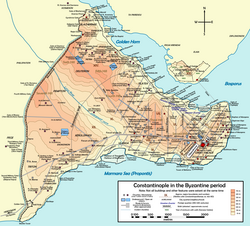Cistern of Aspar
The Cistern of Aspar (Greek: ἡ τοῦ Ἄσπαρος κινστέρνη) or Great Cistern (Greek: μεγίστη κινστέρνη), known in Turkish as Sultan Selim Çukurbostanı ("sunken garden of Sultan Selim"),[1] was a Byzantine open-air water reservoir in the city of Constantinople.
The construction of this cistern, which lay in the fourteenth region of Constantinople, in the area called by the Byzantines Petrion, was started in 459, under Emperor Marcian (r. 450-57), by Aspar, an Alan-Gothic general serving the empire, and by his sons Ardabur and Patricius, during the consulship of Ricimer and Patricius.
[3] According to a tradition, the cistern was directly connected to the Hagia Sophia, which lies about three kilometers southeast, through a passage situated towards the mid of the southeastern side and closed around the middle of the 19th century.
[2] There were two crucial elements which led to the structure's identification: its erection near the wall of Constantine, and its description as "large" (Greek: μεγίστη).
[1] Its walls, 5.20 metres (17.1 ft) m thick [1] and partially still in place, were built using the Roman construction technique named opus listatum by alternating five courses of bricks and five courses of stone, an elegant pattern similar to that also used by the cistern of Aetius.


